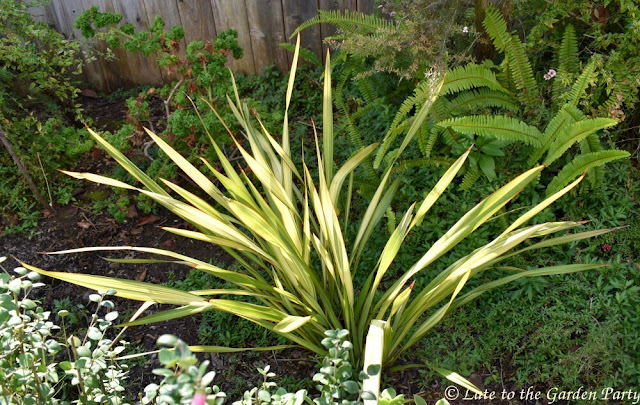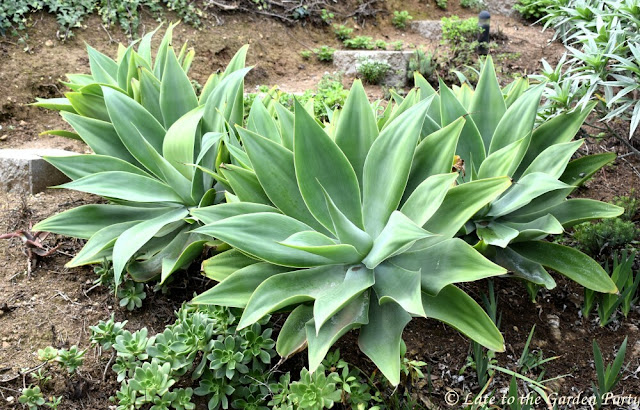Although my garden is already showing signs of gearing up for spring's floral explosion, many of my foliage plants are looking so good they warrant some attention. December's heavier-than-usual rainfall left them spanking clean and well hydrated. This post focuses on a variety of drought-tolerant plants, many but not all of which are succulents.
The south-side garden has become one of my favorite areas, partly because it looks good in every season.
 |
| A few months ago, I filled in gaps in the in the area shown in the foreground here using succulent cuttings from elsewhere in the garden (various Aeoniums and an Agave attenuata 'Raea's Gold'). They're filling in nicely. |
 |
| Euphorbia rigida planted itself between this Agave 'Blue Glow' and Agave 'Blue Flame' but I like how the color picks up that of both the Agaves and the Aeonium 'Sunburst' |
 |
| Aeonium 'Zwartkop' looked terrible before the rains but now it's beautifully echoing the red edges of Agave 'Blue Glow' as it was intended to do |
 |
| Agave mediopicta 'Alba', one of 3 given to me as pups years ago by Hoover Boo of Piece of Eden, is also doing a good job playing off the blue Agaves |
The moderate front-facing slope is often overlooked as it's partially hidden behind the hedge lining the street.
 |
| Most of the succulents on this slope started small or as cuttings |
 |
| Purchased as Agave celsii in 2017, this Agave is now classified as Agave 'Multicolor', a hybrid of A. mitis. I have 2 other smaller specimens here, one a gift from blogger Denise of A Growing Obsession. |
 |
| Aloe labworana could benefit from being moved or at least divided |
 |
| So far, hybrid Aloe vanbalenii x striata hasn't bloomed but it doesn't matter - I love its form |
 |
| These Agave desmettiana were planted here as pups of my first specimen, which bloomed out years ago. With so many Aeonium arboreum bearing bloom spikes this year, I have the opportunity to clear some of the space around them as the blooming rosettes die back. |
The plants that grabbed my attention in the back garden aren't succulents.
 |
| I love the silvery tones of Echium webbii even more than the variegated foliage of Echium candicans 'Star of Madeira' |
 |
| I pruned Hebe 'Purple Shamrock' in November and it's come back well. I probably should have pruned it even harder. |
 |
| I hard-pruned Salvia canariensis in the fall. I like it as much without flowers as with them. |
 |
| Every year when I prune this Melianthus major (usually earlier than recommended), I fear I've gone too far but it always bounces back. I admire the leaves that look as though they were cut with pinking shears. |
When we moved in, I had very low expectations for the north-side garden but it's become another of my favorite areas.
 |
| I had to search my records to give this Agave a name. It's Agave capensis, purchased as a tiny plant through The Huntington Garden's International Succulent Introductions (ISI) program in October 2015. The species is often a messy clumper but this is a solitary specimen. |
 |
| I purchased this Phormium tenax 'Yellow Wave' in 2011. It's showing off to better advantage since I pruned the Correa 'Pink Eyre' in front of it. (Note: This is NOT the Phormium shown next to Agave capensis in the earlier photo. That one is P. tenax 'Apricot Queen', also purchased in 2011.) |
 |
| While pruning and cleaning up the north-side area this week, I uncovered 2 Agave pups. The one on the left was growing in the gravel walkway, hidden underneath a mass of Aeonium 'Kiwi', and I haven't a clue what it is as it doesn't look like any of its neighbors. The pup on the right is Agave funkiana 'Blue Haze'. |
I had very low expectations of the back slope when we moved in and I still do. This area frustrates me more than any other. Its steep slope, the inability get heavy equipment in there because of the way it's sandwiched between two neighboring properties, and our deepening drought have all impacted my options for this area. The presence of fire ants has also dissuaded me from doing much there during the warm months when the ants are most active. That said, the area has some positive attributes.
 |
| As I recall, all the Agave attenuata shown here were transplanted as pups of the specimen I inherited with the garden. Their success relative to other plants I've introduced in this area of the slope has led me to believe that I should plant the entire area in succulents. |
 |
| My Drimia maritima (aka giant sea squill) didn't bloom last year but their foliage is a bigger attraction than their flowers for me anyway. The plants die back completely in summer, reappearing once it rains again in the fall/winter. Shown here are 2 views of the largest specimen, planted as a bulb in 2019. |
 |
| I added 4 more of the gigantic bulbs in 2020, all of which you can see in this photo. They sit across from the lemon tree, very close to the property line. The ivy that creeps over from the neighbor's property is another headache associated with the back slope. |
January is proving to be as dry as earlier forecasts projected, at least in my area. We got two hundredths of an inch of rain last Saturday and that's been it for the month with no significant chance of rain on the horizon in the the next ten days. Hopefully, February, traditionally the rainiest month of our short rainy season, will be better.
All material © 2012-2022 by Kris Peterson for Late to the Garden Party



















Oh, I'm so glad you've gotten some much-needed rain. Your plants look so happy and healthy! The Agaves, in particular, are so lush. :)
ReplyDeleteI love that you describe the Agaves as lush, Beth! I agree.
DeleteSigh... what can I say? Hard to speak when I'm drooling. So very gorgeous...
ReplyDeleteThanks Anna!
DeleteKris, I know you've had to work through a lot of trial and error to get your foliage plantings so right; but the results are really wonderful. And inspiring (especially that front slope). :) I love your selection of agaves but also the softer foliage you've used, especially that melianthus!
ReplyDeleteI'm having to study up on frost-hardy desert foliage plants, finding some of my favorites are actually hardier than I thought, but definitely not all. Anyway I'm most grateful for the inspiration!
Some people describe Melianthus as boring but I love it even without the blooms. It flowered well last year, especially given our very low rainfall, and I'm looking forward to a repeat of those dramatic blooms this year.
DeleteI used to love the 'Foliage Follow Up' meme (it followed blogger's bloom day). Foliage isn't as fleeting as flowers, so when a garden space is designed with foliage combinations in mind, it shines year round. Aeonium 'Zwartkop' and A. 'Blue Glow' are stunning together; no wonder the south-side garden has become your favorite.
ReplyDeleteI participated in Pam Penick's Foliage Follow-up meme from the time I started blogging (my first foliage post was in January 2013) until Pam called it quits. I still run regular foliage posts albeit on a laxer schedule.
DeleteThis one post manages to gather together many of my favorites in your garden, except of course the protea family and the bromeliads. So many beautiful plants, you've created a wonderland Kris!
ReplyDeleteAs so many of the Leucadendrons "flower" this time of year, I decided they got enough coverage on Bloom Day. It looks like all my Leucospermums are developing buds so I'm looking forward to a good show from them this year. Now if I could only get my Protea 'Pink Ice' would just do something....
DeleteCool angle for photo with the path on either side of the succulent bed. Looks great! Funny I did foliage too. The rain made everything look so good.
ReplyDeletehaving posting problems again, hope this time it works.
I had some odd - but temporary - issues with Blogger today so perhaps there was a glitch. I noticed that you and I were attuned with respect to our subject matter ;)
DeleteI love this post. You have so many cool succulents. I love Agave capensis, a very uncommon species.
ReplyDeleteAs for the back slope, I think it would be stunning covered with dozens of Agave attenuata!
I was somewhat disappointed with Agave capensis during the first several years but it's matured well! Thus far, even in terms of succulents, Agave attenuata seems to be the most well adapted plant growing on my back slope but then I've yet to try any other agaves down there.
DeleteOh my such gorgeous agaves and aeoniums. They all look happy and pristine. Resilient plants capable of taking multiple weather situations are definitely the way to go these days no matter where you live.
ReplyDeleteAll too true, Elaine.
DeleteEverything is looking healthy after the recent rain, Kris. I love the textures of the various foliage, esp. the flowing lines of Agave, esp. Blue Flame and attenuata. Aloe labworana looks like a prickly octopus!
ReplyDeleteIt's true - Aloe labworana is well-suited to an undersea-themed succulent garden!
Delete